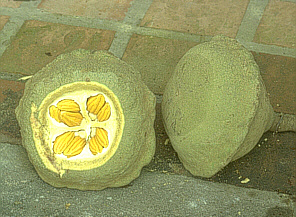
Fruits are a uniquely angiosperm feature: part of the pollinated
flower ripens and becomes the fruit. Two types of fruits with a
generally different mechanism of seed distribution exist: dehiscent
and nondehiscent fruits. Dehiscent fruits set the
seeds free by opening of the fruit that remains itself with the
mother plant. In contrast, nondehiscent fruits and their seeds are a
dispersal unit. Dehiscent fruit types are follicles, pulses, pods and
capsules. Nondehiscent fruits are berries, drupes and nuts. Seeds
are normally surrounded by a tough shell, the testa, that is derived
from one or more integuments. It contains the endosperm, a nourishing
tissue. Seeds are dispersed either by self-dispersal, also called
autochory, or by allochory
which means that extern factors are involved. Allochor modes of
dispersal are dispersal by wind (anemochorys), water (hydrochory) or
by animals (zoochory).
Fructification is a feature of angiosperms during which the seeds are encapsulated by the ovary. Gymnosperms develop seeds that lie naked on the carpels.
A fruit is the state that the flower turns to during the ripening of the seeds. Perianth and stamens have usually withered and fallen off. During fructification, the gynoecium is largely rearranged, the ovary extends strongly, the stigma shrivels and the style normally degenerates or falls off but it, too, may develop further, if it serves to enlarge the fruit.
In the simplest case, the seeds are set free from the ovary after ripening by opening of the fruit (dehiscent fruits). But very often, both fruits and seeds form an integrated part of the dispersal unit (nondehiscent fruit). If this happens, the tissue of the ovary is strongly differentiated. The pericarp is the part of a fruit that is formed by the ripening of the ovary wall. It is organized into three layers: the skin (exocarp), the often fleshy middle (mesocarp), and the membranous or stony inner layer (endocarp). These layers may become skin-like and leathery, fleshy or stringy (sclerotic) during fructification. The fruits produce gadgets for the protection and the dispersal of the seeds. Additionally, other parts of the flower may contribute to the formation of the fruit, like the flower axis (strawberry) or the calyx. Depending on the organization of the gynoecium, single fruits or multiple fruits develop. Single fruits spring either from a monomer (coenocarp) gynoecium or from single carpels of an apocarp gynoecium while multiple fruits develop from flowers with a choricarp gynoecium.
If the fruit opens up to free ripe seeds, it is a dehiscent fruit where the pericarp is always dry. Contrasting are indehiscent fruits where the seed is spread together with the fruit or parts of the fruit.
Follicle: It is regarded as the most primitive type of fruit and is common in the ranunculaceen family. The fruit is composed of a single carpel. Opening occurs usually at the ventral suture as with the fruits of larkspur (Delphinium). In rare cases, it does take place at the dorsal suture (Magnolia, for example).
Pulses: This is the type of fruit that occurs with leguminoses. Contrary to the follicles, both ventral and dorsal suture open at the same time. Both parts of the carpel wind normally up like a screw. The process may occur like an explosion so that the seed is hurled away with full force (autochory, see beneath).
Pods are typical for cruciferous plants (Cruciferae, Brassicaceae). A pod stems from a paracarp ovary. It includes only two carpels and is divided by a central septum. When ripening, two flaps fall off while the septum and the placentas (replum) stay. The seeds may stick to them for a while.
Capsules are a very widespread
type of fruit. They develop from a coenocarp gynoecium, the pericarp
is dry. The opening of the fruit can take place in multiple ways by
longitudinal tears, pores or by raising of the lid.
Indehiscent fruits do not scatter their seeds. It is distinguished between berries, drupes, and nuts depending on the composition of the pericarp.
The pericarp of berries becomes fleshy and juicy in all its parts and is often colored. A berry like, for example, a tomato contains many seeds. The endocarp of drupes differentiates into a stone that encapsulates usually only one seed. The outer layers of the fruit (mesocarp and exocarp) are, just like with berries, fleshy. Well-known examples are cherries, plums, peaches, olives, and walnut. Berries and drupes have adapted to endozoochory, i.e. they are eaten by animals (birds, mammals) along with the seeds. The seed (sometimes together with the stony endocarp) is excreted without being digested and is thereby scattered. The whole pericarp of nuts becomes hard and develops a thick wall which includes as a rule only one seed (hazelnut, acorn).
The caryopsis of sweet grass
belongs to the nuts. Its seed is surrounded by a rather thin shell
that is fused with the outer layer of the fruit. Other nut types are
the achenes of composite flowers
(Compositae, Asteraceae) where the calyx has been rearranged into a
pappus (a structure for flying). An especially interesting case is
the coconut (Cocos nucifera) where the outer layer is fibrous
so that the fruit is able to swim due to the enclosed air.
Multiple fruits develop from flowers with an apocarp (choricarp) gynoecium. The single fruit may have a dry outer layer (single-seeded nuts or follicles with only few seeds) or the outer layer may be fleshy just like that of a drupe. Several fruits are usually combined to a unit by an axial structure that is either a central axial cone (strawberry, blackberry) or an axial cupule (rose hip, apple).
With some species, the numerous fruits that develop from the inflorescences stay together as a functional unit (syconium). Well-known examples are mulberry (Morus) and fig (Ficus).
a. distribution by wind. Flat, very light, small and dry pods with a relatively large surface and just one or two seeds per fruit (Lunaria annua, Brassicaceae)
b. "Bodenroller" (winged fruits rolling along the ground): three-dimensionally built, dry and very light fruits that are easily blown away in dry habitats (Pterodiscus ungamicus, Pedaliaceae)
c. distribution by wind, burdocks and "Bodenroller" (winged fruits rolling along the ground), a triple strategy. Flat, dry involucre with a large surface but rather heavy. It can therefore only travel short distances by wind alone. The spiky centre serves epizoochoric distribution by animals; the arrangement of the wing-like gadgets allows an additional drifting at the floor (Pterocarpus angolensis, Fabaceae).



d. trample burs: lignified fruit shell with spikes and barbs that stick to the softer parts of mammals' hoofs and are dispersed this way (Harpagophytum procumbens, Pedaliaceae).
e. distribution by burdocks: dry fruits with barbs at their surfaces that stick to the fur of mammals. Relatively strong structure of the fruit that falls apart by and by so that the seeds are very effectively lost at different places (Xanthium riparium, Compositae)


f. trample bur: dry and very compactly built fruit with a "drawing pin-principle". This fruit is only dispersed by the hoofs of mammals, it cannot adhere to their fur (Dicerocaryum senecioides, Pedaliaceae)
g. and one more trample bur: this one can also stick to animals' furs. The fruits are, too, able to cling one to another. The respective animal may be hurt by the spikes (Harpagophytum procumbens, Pedaliaceae) (leg. et det. H.-D. IHLENFELDT, photos by A. FOCK, 1985)


trample bur: dry and very compactly built fruit with a "drawing pin-principle". This fruit is only dispersed by the hoofs of mammals, it cannot adhere to their fur (Dicerocaryum senecioides, Pedaliaceae)

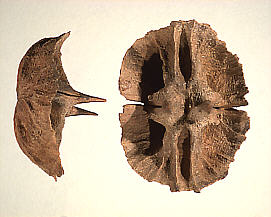
distribution by wind. Flat, very light, small and dry pods with a relatively large surface and just one to three seeds per fruit (Lunaria annua, Honesty, Silver Dollar, Pennyflower - Brassicaceae).
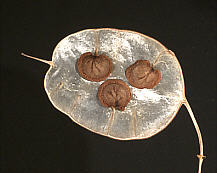
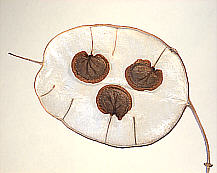
distribution by burdocks: dry fruits with barbs at their surfaces that stick to the fur of mammals. Relatively strong structure of the fruit that falls apart by and by so that the seeds are very effectively lost at different places (Xanthium riparium, Compositae)
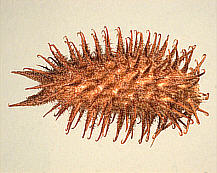
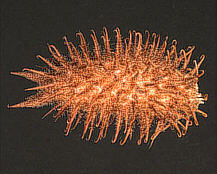
Macrophotos, taken with Color View Digitalcamera, computerenhanced with Analysis (Soft Imaging System, Corp.) - Photos.: A. ANDRES, Institute for Applied Botany, University of Hamburg
Seeds are normally surrounded by a tough shell (Testa) that develops from the integument (or several integuments) and that protects a largely developed embryo and its nutriments. The embryo is thus preserved from loss of water and bad weather. The nutriments are in a special nourishing tissue, the endosperm or in the perisperm (developed from tissue of the nucellus as with pepper). They have either to be made useable and to be used during germination or they are already stored in the cotyledons (beans, peas, almonds). Monocotyledons have normally only one cotyledon, dicots have two and gymnosperms several.
With many species, the seeds are unable to germinate immediately after falling off the plant (dormancy). This dormancy can be overcome by a period of cold weather (vernalisation) so that the seeds do not germinate before the beginning of the next period of vegetation.
The number of seeds that is produced by a single plant in the course of its life varies enormously. Some species like the coconut palm produce only few but very well provided descendants while others produce up to several million seeds that are inevitably provided rather badly. Numerous devices support the dispersal of the descendants since only a suitable habitat enables the seed to develop into a viable plant. If the dispersal is achieved only through devices that the plant itself produces, it is spoken of self-dispersal or autochory. If extern factors such as wind, water, animals, etc. are involved, then the mode of dispersal is called allochor. Only rarely the seeds are spread on their own, usually the whole seed-containing fruit is scattered. Among the autochor modes of dispersal is flinging and spurting of seeds.
Dispersal by wind (anemochory) is widespread among plants. The units for dispersal are necessarily either very small and light and / or equipped with specially formed devices for flying or floating. Those devices are, for example, air-filled cavities in the seeds of orchids, seeds that are completely covered with hairs like cotton, pappus-bearing seeds (composite flowers) and units that are equipped with all different kinds of wings.
Dispersal by water (hydrochory) is much less common. Seeds that are spread by water have often an outer layer that cannot be moistened or they are hairy in order to trap air bubbles. Some big fruits that are spread by ocean currents like the coconut are surrounded by a loosely structured, airy layer.
Zoochory, i.e. the dispersal of fruits with the aid of animals has already been met when talking about berries, drupes, and multiple fruits. If seeds are eaten and excreted again, this is called endozoochoric dispersal. Contrasting is epizoochoric dispersal where the seeds or fruits stick to the animal or its fur either by slimy secretings or by variably shaped barbs.
A speciality in the dispersal through animals is that through ants (myrmecochory). Such seeds or fruits bear attachments, the elaiosomes that contain lures and nutriments. Myrmecochory is common with plants that live at the forest soil like violets (Viola).
The given examples show that zoochory offers a variety of possible mechanisms for the dispersal of seeds. But this variety is far beyond that of the architectural design of flowers. This is due to the fact that specialization and adaptation to seed or fruit dispersing animals is far less advanced than the specialisation of pollination.
|
|